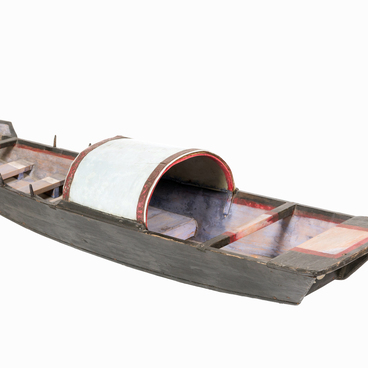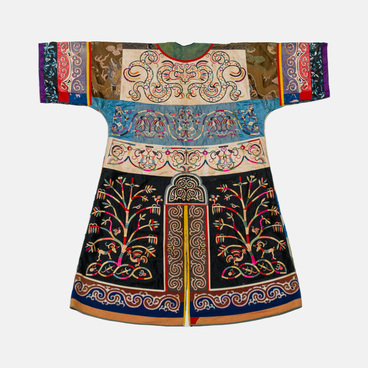An amiri is an upper shoulder garment, the most ancient robe of the Ulchi people. This one-piece robe was made of fish skin. Nanai craftswomen used the skin of chun salmon, carp and pike to make it. It was dried and treated in a special way, so that it became durable, waterproof and breathable. It was like velvet to the touch. The craftswomen carefully selected materials in terms of texture and color.
The robe on display was made based on the kimono cut. The back, panels and part of the sleeves were made of one cloth, which was folded in half along the shoulders. The sleeves were made short and narrow so that they did not obstruct the work. The lower part of the cut smoothly passes into the flared panel of the robe.
To widen the panel, gussets were sometimes sewn into the sides. The bottom of the panel was cut in the form of a semicircle, the left one was wrapped over the right one and fastened with five buttons. Slits were made on the sides to make it easier for a person to move.
The festive female robes often had decorative patterns on the collar, sleeves, back and sides. The Nanai people could unmistakably identify the clan to which the owner of the amiri belonged. The patterns were vegetal, sometimes combined with zoomorphic designs. The images of birds, fish and reptiles were recognizable in the pattern. Most often there were paired figures of dragons facing each other. According to ancient beliefs, the mudur dragon, a good spirit of thunder and lightning, protected women from evil spirits.
Images were applied with natural dyes. Blue was extracted from blue field flowers, red — from pine bark or cranberry, which was boiled in the bark, black — from a mixture of grated soot and caviar of chun salmon or bird cherry.
Oftentimes strips of brightly colored fabric were sewn along the lower edge of the robes, on the ends of the sleeves, around the collar, and to the upper part of the edge of the left hemline. Jewelry, metal plaques were attached to the fabric. The metal weighed down the hem, emphasizing the style of the outfit, while the ringing of the plaques was believed to scare away evil forces.
Later, appliqué patterns
appeared on amiri robes. Nanai craftsmen made compositions out of pieces of
fish skin and fixed them on the base with fish glue. The whole arrangement was
stitched on the edge of the robe with decorative stitching.



